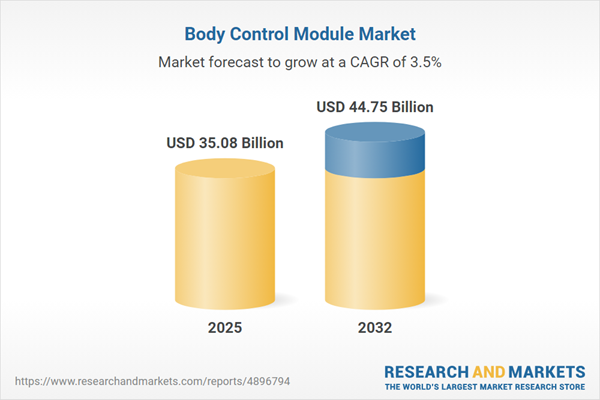Speak directly to the analyst to clarify any post sales queries you may have.
The global Body Control Module Market is evolving rapidly as new technologies, regulatory requirements, and changing vehicle architectures drive strategic shifts across the automotive value chain. Senior executives must anticipate trends, assess risks, and seize emerging opportunities to remain competitive in this critical sector.
Market Snapshot: Growth Drivers and Industry Scale
The Body Control Module Market grew from USD 33.89 billion in 2024 to USD 35.08 billion in 2025. It is expected to continue growing at a CAGR of 3.53%, reaching USD 44.75 billion by 2032. This growth is propelled by the increasing complexity of vehicle electronic systems, expanding adoption of electrified powertrains, and evolving integration needs supporting safety, comfort, and connectivity. Global manufacturers, OEMs, and suppliers are intensifying collaborative investments to scale innovation and capitalize on changing vehicle infrastructures.
Scope & Segmentation
This report delivers comprehensive insight into the Body Control Module Market by addressing all major segments, technologies, and regional trends:
- Propulsion Types: Battery Electric Vehicle, Fuel Cell Electric Vehicle, Hybrid Electric Vehicle
- System Voltage: 12V, 48V
- Integration Levels: Integrated, Stand Alone
- Applications: Central Gateway, Comfort and Convenience (HVAC, Mirror Control, Seat Control), Lighting, Networking (CAN, Ethernet, FlexRay, LIN), Security and Access
- Vehicle Types: Heavy Commercial Vehicle, Light Commercial Vehicle, Passenger Car
- Distribution Channels: Aftermarket, OEM
- Regional Coverage: Americas (United States, Canada, Mexico, Brazil, Argentina, Chile, Colombia, Peru), Europe, Middle East & Africa (United Kingdom, Germany, France, Russia, Italy, Spain, Netherlands, Sweden, Poland, Switzerland, UAE, Saudi Arabia, Qatar, Turkey, Israel, South Africa, Nigeria, Egypt, Kenya), Asia-Pacific (China, India, Japan, Australia, South Korea, Indonesia, Thailand, Malaysia, Singapore, Taiwan)
- Key Companies Covered: ALTEN Global Technologies Private Limited, Aptiv PLC, CARDONE Industries, CHINT Group Co., Ltd., Clientron, Continental AG, FORVIA Group, General Motors Company, Infineon Technologies AG, INOMO Technologies AG, L&T Technology Services Limited, Luxshare Precision Industry Co., Ltd., Micro Commercial Components (MCC), Inc., Mitsubishi Electric Corporation, Nisshinbo Micro Devices Inc., NXP Semiconductors N.V., Panasonic Holdings Corporation, Renesas Electronics Corporation, ROHM CO., LTD., Semiconductor Components Industries, LLC, STMicroelectronics N.V., Tata Elxsi, Texas Instruments Incorporated, Visteon Corporation
Key Takeaways for Senior Decision-Makers
- The body control module sector is rapidly advancing to support electrification strategies, software-defined vehicle initiatives, and stringent compliance in safety and cybersecurity.
- Increased integration of networking standards and secure data exchange is reshaping control architectures for enhanced real-time processing and cross-domain communication.
- Regional market priorities differ significantly, with technology adoption paced by regulatory mandates, infrastructure maturity, and localized design needs across North America, EMEA, and Asia-Pacific.
- Strategic partnerships and investments in modular software platforms are unlocking faster product development, R&D efficiencies, and differentiated service offerings.
- Emerging trends in aftermarket and OEM distribution channels highlight the growing importance of retrofit solutions and continuous lifecycle support.
Tariff Impact on the Body Control Module Market
The introduction of targeted tariffs on electronic components and semiconductors, particularly in the United States, has increased input costs and supply chain volatility for manufacturers and tier-one suppliers. The resulting shifts toward nearshoring, renegotiation of supplier contracts, and heightened focus on alternative sourcing strategies have intensified competitive pressures on operational efficiency and innovation. As organizations pursue software-driven consolidation to manage total system costs, the need for flexible, resilient procurement and design frameworks has become critical for business continuity and profitability.
Methodology & Data Sources
This report combines primary interviews with leaders at OEMs, tier-one suppliers, and industry consultants with comprehensive secondary research. The data is validated through triangulation methods, cross-referencing publicly available documents, regulatory publications, technical white papers, and peer-reviewed journals. Quantitative analysis ensures findings are consistent and actionable.
Why This Report Matters to Industry Leaders
- Equips senior executives with a nuanced understanding of market drivers, risk factors, and strategic levers influencing body control module design.
- Offers actionable segmentation and competitor analysis to guide investment, procurement, and technology development priorities.
- Highlights critical shifts in supply networks and emerging aftermarket trends that affect market positioning.
Conclusion
The Body Control Module Market is defined by rapid innovation, evolving compliance landscapes, and growing demand for modular, secure solutions. By leveraging these insights, industry leaders can confidently shape strategies in design, sourcing, and partnership development for sustained market leadership.
Additional Product Information:
- Purchase of this report includes 1 year online access with quarterly updates.
- This report can be updated on request. Please contact our Customer Experience team using the Ask a Question widget on our website.
Table of Contents
3. Executive Summary
4. Market Overview
7. Cumulative Impact of Artificial Intelligence 2025
Companies Mentioned
The companies profiled in this Body Control Module market report include:- ALTEN Global Technologies Private Limited
- Aptiv PLC
- CARDONE Industries
- CHINT Group Co., Ltd.
- Clientron
- Continental AG
- FORVIA Group
- General Motors Company
- Infineon Technologies AG
- INOMO Technologies AG
- L&T Technology Services Limited
- Luxshare Precision Industry Co., Ltd.
- Micro Commercial Components (MCC), Inc.
- Mitsubishi Electric Corporation
- Nisshinbo Micro Devices Inc.
- NXP Semiconductors N.V.
- Panasonic Holdings Corporation
- Renesas Electronics Corporation
- ROHM CO., LTD.
- Semiconductor Components Industries, LLC
- STMicroelectronics N.V.
- Tata Elxsi
- Texas Instruments Incorporated
- Visteon Corporation
Table Information
| Report Attribute | Details |
|---|---|
| No. of Pages | 192 |
| Published | November 2025 |
| Forecast Period | 2025 - 2032 |
| Estimated Market Value ( USD | $ 35.08 Billion |
| Forecasted Market Value ( USD | $ 44.75 Billion |
| Compound Annual Growth Rate | 3.5% |
| Regions Covered | Global |
| No. of Companies Mentioned | 25 |









